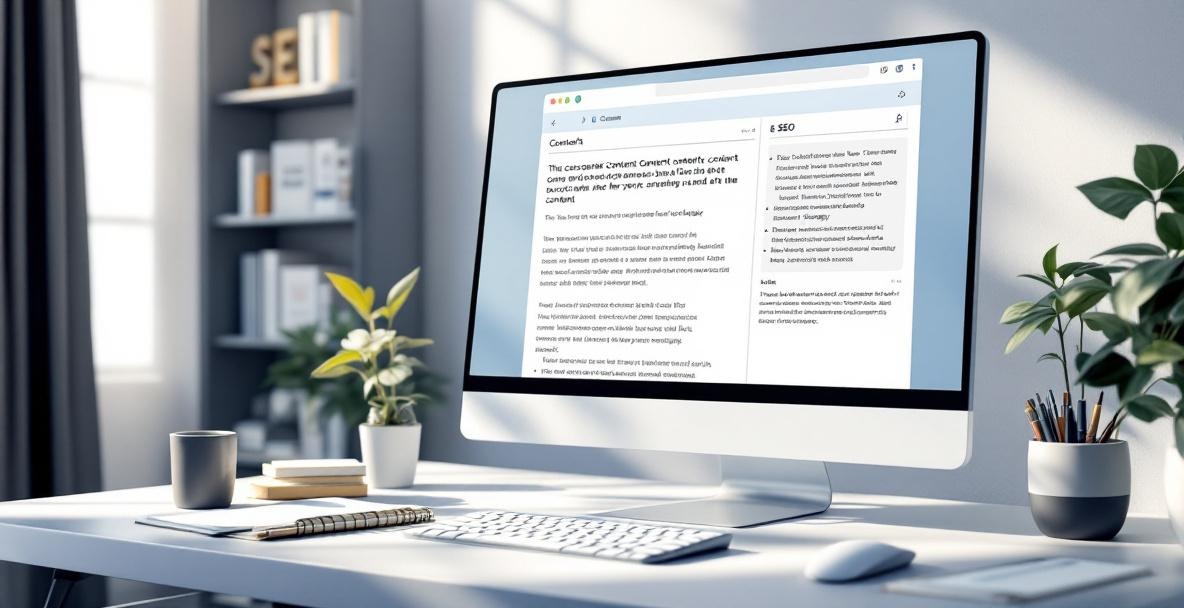Ever felt frustrated when pages feel messy and your main points get lost? When your ideas are arranged clearly, readers stick around longer and feel more connected to your message. A well-planned layout makes your work stand out and guides search engines to spot what truly matters. At SeoFlow, we know that turning a jumble of thoughts into a friendly roadmap can change the game for engagement and conversion.
Why a Clear Content Layout Is Essential

Good organization is like a friendly map that shows readers exactly where to go. It makes your content easy to follow and helps ideas land where they belong. When your layout is strong, every word finds its place and every point matters. A clear format builds trust and keeps visitors interested instead of quickly bouncing off a confusing page.
The Trouble with Jumbled Content
When text is thrown together with no clear breaks, it can really wear out your readers. Big blocks of text and muddled ideas force the mind to work too hard, which makes people lose focus. This mental strain means they miss important points and often leave without getting much value. A neat structure saves time and energy for everyone reading your work.
Mobile devices make this problem even worse. On smaller screens, endless paragraphs and hidden key points become painfully obvious. Readers have to dig through messy text to find the good stuff, and that extra effort can push them away. Simple, spaced-out content is essential for keeping mobile users engaged.
What Exactly Is Content Layout?

Your content layout is simply how you arrange your thoughts and ideas on a page. It is the plan that helps every reader follow the flow without getting lost. A strong layout organizes words and ideas so that important points jump out and the overall story feels natural and clear.
A smart structure is not only about making things look pretty; it makes your message work harder for you. By breaking complex topics into easy steps, your layout saves readers from spending too much energy figuring out where to look. When everything is in order, readers can relax and focus on what you have to share. A clear pathway makes the message stick.
Think of your layout as a roadmap that takes someone on a journey through your ideas. It marks the start and the finish and points out the key stops along the way. This steady flow helps readers move smoothly from one thought to the next without confusion. A rhythmic layout keeps your audience hooked.
What Makes a Great Content Layout?
A solid content layout works like a well-organized toolbox where every tool has its own spot. The most important part is the order of your ideas. This means your main points come first, and your supporting details follow neatly behind. A proper hierarchy helps your key messages shine and makes sure everything fits into a clear picture.
Giving your words room to breathe is just as important. Breaks in the text, like clear headings and paragraph changes, let readers pause and really take in your points. Open space within your writing prevents the page from feeling too cramped and makes the journey easier.
Keeping a steady style throughout your text is also key. When your fonts, spacing, and tone stay consistent, readers quickly learn where to find what they need. A consistent look builds comfort and makes your ideas easier to remember.
Simple words that connect each idea serve like bridges in your story. They gently move your readers from one topic to the next and keep the writing feeling natural and smooth. Smooth transitions keep the conversation flowing.
Simple Ways to Make Your Content Easy to Read

How your page looks plays a huge role in how people read it. It is not only about the words you choose, but also the way they are presented. A smart presentation makes your content inviting and turns tricky topics into easy reads that feel almost like a friendly chat.
Crafting Headings That Guide Your Readers
Headings are like helpful signs along a familiar path. They do more than just label sections; they offer a peek at what comes next and break the text into bite-sized pieces. Clear headings invite readers in and make it easy for anyone to pick up the big ideas quickly.
Keep your headings simple and honest instead of overly clever. While fun titles can catch an eye, they must also be clear on what information follows. Descriptive headings set the stage so that both readers and search tools know exactly where to look.
Arrange your headings in a natural order. Use a big title for your main idea, then break out smaller titles for major sections and even smaller ones for details. A logical order in headings makes your story easy to follow and helps everyone quickly grasp your main points.
It also helps to use keywords naturally in your headings. This guides your audience while letting search engines understand the focus of your page. Well-placed keywords in titles boost visibility with no sacrifice in clarity.
Keep Paragraphs Short and Sweet
Online readers often skim rather than read every word, so shorter paragraphs work best. Keeping your ideas in groups of a few sentences makes the text feel less heavy and more approachable. Short paragraphs grab attention and make your key messages pop.
Each paragraph should stick to one main thought. Starting a new paragraph when you bring up a different idea keeps things neat and easy to digest. A focused paragraph tells one clear story without overwhelming the reader.
Mixing up the length of your paragraphs creates a natural rhythm in your writing. Short bits keep the pace lively, and longer ones allow you to dive a bit deeper when needed. A mix of lengths keeps things interesting and helps important points stand out.
Leaving enough white space around your words gives your text room to breathe. This extra space can reduce eye strain, especially on mobile devices, and makes everything feel calmer. Letting the text breathe boosts reader comfort and helps your message stick.
When to Use Lists for Clarity
Sometimes a simple list is the best way to show several ideas side by side. A list can turn a heavy paragraph into clear, easy-to-read points that stand out on their own. Using a list wisely can simplify complex details and highlight what matters most.
If you need to show steps in a process, a numbered list works very well. It tells your reader exactly what comes first and what follows next, leaving no room for confusion. Numbered lists make instructions crystal clear in a friendly, orderly way.
For sharing features or benefits that don't follow a strict order, bullet points are perfect. They help break down information into neat clusters without forcing a strict sequence. Bulleted lists provide quick snapshots that catch the eye without extra clutter.
Keep your lists neat and to the point. Long, complicated lists can do more harm than good, so make sure every item is essential and clear. Concise lists reinforce your message without overwhelming your readers with too much detail.
SEO Basics: Making Your Content Easy to Find

A clean layout benefits not just your readers but search engines as well. When your content is set up clearly, these engines pick up on the key ideas and show your page to more people. A smart structure helps boost your visibility and makes your message easier to find online.
Smart Keyword Use
Using keywords in the right places can really help your page rank higher. Search engines give more weight to words in titles, headings, and the first lines of your paragraphs. Well-chosen keywords capture attention without overloading your text.
It is important to weave them in naturally instead of forcing them into every sentence. Overusing keywords can make your writing sound clunky and hurt your rankings. Natural keyword integration feels genuine and supports your main message effectively.
The depth of your content matters much more than how many times a word appears. Modern search tools look for how well you cover a topic and how organized your ideas are. Check out Ezoic's best SEO practices guide for publishers to see why quality wins every time. Covering topics deeply makes a lasting impact.
At SeoFlow, we help you craft content that reflects your unique voice while staying friendly to search engines. Our approach blends creativity and smart SEO so that your page works well for both you and your readers.
Crafting Meta Tags and Descriptions
Meta tags might not show up on your page, but they work hard behind the scenes to tell search engines what your content is about. Your title tag is the first clue and should include a main keyword upfront. Strong meta tags boost your visibility and set the tone for your page.
Meta descriptions serve as mini-previews that can encourage readers to click through from search results. Though they do not directly affect rankings, a clear description can improve how many people visit your page. A well-written meta description guides readers in and supports your overall message.
Adding structured data through schema can further help search engines understand how your information fits together. This extra step can lead to enhanced listings and rich snippets in search results. Schema markup gives your page an extra edge by clearly outlining your topics.
Finally, align your headings with your meta tags to send a consistent message. When your title, description, and headings all echo the same ideas, search engines see a unified picture. Read ITD Growth Labs' resource on SEO content structure for more ideas. A unified structure makes your content stronger.
Wrapping Up: Level Up Your Content
A smart layout is more than a behind-the-scenes detail. It turns plain words into engaging stories that grab your reader's attention and make your ideas stick. Good structure turns information into connection and builds a lasting bond with your audience.
What You Can Do Right Now
Start by reviewing your current content layout. Look over your paragraphs, headings, and breaks to see if they help readers follow your ideas easily. Check if anything feels too cluttered or confusing, and decide what needs a change. A quick audit can reveal big opportunities to improve.
Develop a set of easy-to-follow templates for your posts. Having a consistent plan for headings, paragraph breaks, and style makes your writing both familiar and inviting. Standards you set up early make future work smoother and more reliable.
Pay attention to what your readers are telling you through their actions. Use tools like heat maps or time-on-page data to see which parts of your layout work best and where things might need a tweak. Real feedback guides smart revisions and keeps your content fresh.
Try making small changes with A/B testing to see which setup your audience prefers. Test different heading styles or varying paragraph lengths and note what really catches their eye. Simple tests can lead to meaningful improvements over time.
Make changes gradually instead of overhauling everything at once. Tweak your layout little by little and measure the results so you can build on what works. Step-by-step upgrades lead to lasting success without overwhelming your readers.
Remember, a strong layout is a work in progress. As readers evolve and technology changes, your approach should adapt too. Keep refining your structure so your content always stays clear and engaging.
Ready to transform your content structure from basic to brilliant? Try SeoFlow today to leverage our AI-driven platform that automatically optimizes your content structure for both readability and SEO performance, helping you create engaging content that ranks higher and converts better.




